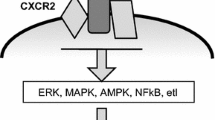Abstract
Free hemoglobin is now recognized as a major mediator of a variety of vascular diseases. The abundant serum protein haptoglobin irreversibly binds to hemoglobin and promotes the uptake of hemoglobin via the macrophage CD163 receptor. The haptoglobin gene is polymorphic in man with two common alleles denoted 1 and 2. The haptoglobin genotype specifies the nature of the response of the macrophage to free hemoglobin. Hp 1-Hb complexes stimulate an anti-inflammatory macrophage phenotype while Hp 2-Hb complexes do not. We have previously demonstrated that Hp 1-Hb induced anti-inflammatory cytokine production is critically dependent on casein kinase II. In this study we set out to determine whether the amount or the activity of casein kinase II associated with CD163 was altered by the binding of Hp 1-1-Hb to CD163. Our results indicate that casein kinase II activity is increased by the binding of Hp 1-1-Hb to CD163.





Similar content being viewed by others
References
Rother RP, Bell L, Hillmen P, Gladwin MT (2005) The clinical sequelae of intravascular hemolysis and extravascular plasma hemoglobin. A novel mechanism of human disease. JAMA 293:1653–1662. doi:10.1001/jama.293.13.1653
Kristiansen M, Graversen JH, Jacobsen C, Sonne O, Hoffman HJ, Law SK et al (2001) Identification of the hemoglobin scavenger receptor. Nature 409:198–201. doi:10.1038/35051594
Langlois MR, Delanghe JR (1996) Biological and clinical significance of haptoglobin polymorphism in humans. Clin Chem 42:1589–1600
Levy AP, Hochberg I, Jablonski K, Resnick HE, Lee ET, Best L et al (2002) Haptoglobin phenotype is an independent risk factor for cardiovascular disease in individuals with diabetes: Strong Heart Study. J Am Coll Cardiol 40:1984–1990
Roguin A, Koch W, Kastrati A, Aronson D, Schomig A, Levy AP (2003) Haptoglobin genotype is predictive of major adverse cardiac events in the 1 year period after percutaneous transluminal coronary angioplasty in individuals with diabetes. Diabetes Care 26:2628–2631. doi:10.2337/diacare.26.9.2628
Milman U, Blum S, Shapira C, Aronson D, Miller-Lotan R, Anbinder Y et al (2008) Vitamin E supplementation reduces cardiovascular events in a subgroup of middle-aged individuals with both Type 2 Diabetes Mellitus and the Haptoglobin 2-2 genotype: a prospective, double-blinded clinical trial. Art Thromb Vasc Biol 28:341–347. doi:10.1161/ATVBAHA.107.153965
Levy AP, Moreno PR (2006) Intraplaque hemorrhage. Curr Mol Med 6:479–488. doi:10.2174/156652406778018626
Asleh R, Marsh S, Shilkrut M, Binah O, Guetta J, Lejbkowicz F et al (2003) Genetically determined heterogeneity in hemoglobin scavenging and susceptibility to diabetic cardiovascular disease. Circ Res 92:1193–1200. doi:10.1161/01.RES.0000076889.23082.F1
Guetta J, Strauss M, Levy NS, Fahoum L, Levy AP (2007) Haptoglobin genotype modulates the balance of Th1/Th2 cytokines produced by macrophages exposed to free hemoglobin. Atherosclerosis 91:48–53. doi:10.1016/j.atherosclerosis.2006.04.032
Ritter M, Buechler C, Kapinsky M, Schmitz G (2001) Interaction of CD163 with the regulatory subunit of casein kinase II (CKII) and dependence of CD163 signaling on CKII and protein kinase C. Eur J Immunol 31:999–1009. doi:10.1002/1521-4141(200104)31:4<999::AID-IMMU999>3.0.CO;2-R
Allende JE, Allende CC (1995) Protein kinase CK2: an enzyme with multiple substrates and a puzzling regulation. FASEB J 9:313–323
Olsten ME, Litchfield DW (2004) Order or chaos? An evaluation of the regulation of protein kinase CK2. Biochem Cell Biol 82:681–693. doi:10.1139/o04-116
Raman C, Kuo A, Deshane J, Litchfield DW, Kimberly RP (1998) Regulation of casein kinase II by direct interaction with cell surface receptor CD5. J Biol Chem 273:19183–19189. doi:10.1074/jbc.273.30.19183
Litchfield DW, Lozeman FJ, Cicirelli MF, Harrylock M, Ericsson LH, Piening CJ et al (1991) Phosphorylation of the beta subunit of casein kinase II in human A431 cells: identification of the autophosphorylation site and a site phosphorylated by p34cdc2. J Biol Chem 266:20380–20388
Litchfield DW, Luscher B, Lozeman FJ, Eisenman RN, Krebs EG (1992) Phosphorylation of casein kinase II by p34cdc2 in vitro and at mitosis. J Biol Chem 267:13943–13949
Mulner-Lorillon O, Cormier P, Labbe JC, Doree M, Poulhe R, Osborne H et al (1990) M phase specific cdc 2 protein kinase phosphorylates the beta subunit of casein kinase II and increases casein kinase II activity. Eur J Biochem 193:529–534. doi:10.1111/j.1432-1033.1990.tb19368.x
Acknowledgments
This work was supported by grants from the US-Israel Binational Science Foundation and the Israel Science Foundation to APL.
Author information
Authors and Affiliations
Corresponding author
Rights and permissions
About this article
Cite this article
Strauss, M., Levy, A.P. Regulation of CD163 associated casein kinase II activity is haptoglobin genotype dependent. Mol Cell Biochem 317, 131–135 (2008). https://doi.org/10.1007/s11010-008-9840-3
Received:
Accepted:
Published:
Issue Date:
DOI: https://doi.org/10.1007/s11010-008-9840-3




